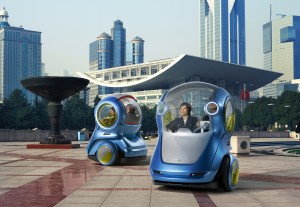 With continued population growth, 60 percent of the world?s 8 billion people are expected to live in urban areas by 2030.? With that, the demand for transportation will escalate toward gridlock, unless more is done to head off the problem.
With continued population growth, 60 percent of the world?s 8 billion people are expected to live in urban areas by 2030.? With that, the demand for transportation will escalate toward gridlock, unless more is done to head off the problem.
General Motors and its strategic partner, Shanghai Automotive Industry Corp. Group (SAIC), share a common vision for addressing the need for personal mobility through a radical change in personal urban transportation.? They are exploring several solutions for tomorrow?s drivers.? Among the most promising is a new vehicle form called EN-V.
EN-V, which is short for Electric Networked-Vehicle, maintains the core principle of personal mobility ? freedom ? while helping remove the motor vehicle from the environmental debate.? EN-V is a two-seat electric vehicle that was designed to alleviate concerns surrounding traffic congestion, parking availability, air quality and affordability for tomorrow?s cities.
Three EN-V models have been developed, each representing different characteristics that emphasize the enjoyable nature of future transportation: Jiao (Pride), Miao (Magic) and Xiao (Laugh).? The concepts will be showcased from May 1 through October 31 at the SAIC-GM Pavilion at World Expo 2010 Shanghai.
 EN-V?s platform has evolved from the platform of the Personal Urban Mobility and Accessibility (P.U.M.A.) prototype that was developed by Segway and debuted in April 2009.? Segway has worked collaboratively with GM to develop and deliver multiple copies of the drivetrain platform that seamlessly connect to and power the various EN-Vs.
EN-V?s platform has evolved from the platform of the Personal Urban Mobility and Accessibility (P.U.M.A.) prototype that was developed by Segway and debuted in April 2009.? Segway has worked collaboratively with GM to develop and deliver multiple copies of the drivetrain platform that seamlessly connect to and power the various EN-Vs.
EN-V is propelled by electric motors in each of its two driving-mode wheels.? Dynamic stabilization technology empowers EN-V, giving it the unique ability to carry two passengers and light cargo in a footprint that?s about a third of a traditional vehicle.? It can literally ?turn on a dime? within its own operating envelope.? In addition, everything in EN-V is drive-by-wire, supporting its ability to operate autonomously or under manual control. The motors not only provide power for acceleration, but also bring the vehicle to a stop.
Power for the motors is provided by lithium-ion batteries that produce zero emissions. Recharging can occur from a conventional wall outlet using standard household power, allowing EN-V to travel at least 25 miles on a single charge.? EN-V can also improve the efficiency of the public electric infrastructure since the vehicle can communicate with the electric grid to determine the best time to recharge based on overall usage.
By combining the Global Positioning System (GPS) with vehicle-to-vehicle communications and distance-sensing technologies, the EN-V concept can be driven both manually and autonomously.
The ability to communicate with other vehicles and with the infrastructure could dramatically reduce the number of vehicle accidents.? Using vehicle-based sensor and camera systems, EN-V can ?sense? what is around it, allowing the vehicle to react quickly to obstacles or changes in driving conditions. For example, if a pedestrian steps out in front of the vehicle, EN-V will decelerate to a slower and safer speed and stop sooner than today?s vehicles.








